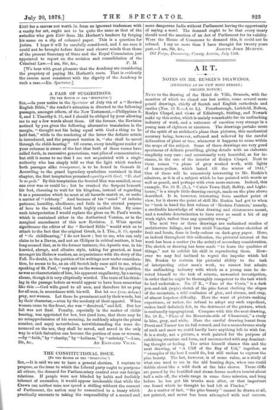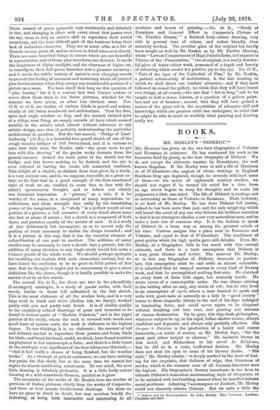ART.
[SECOND NOTICE.]
NexT to the drawing of the Hotel de Ville, Brussels, with the mention of which we closed our last notice, come several more pencil drawings, chiefly of Scotch and English cathedrals and castles (Nos. 24 IL—A to L). Peterborough, Lichfield, Bolton, Roslyn Chapel, and views of Edinburgh, Stirling, and Newark make up this series, which is mainly remarkable for its unflinching industry of work, and a reticence of emotion very strange in a young man of eighteen or nineteen. The drawings partake more of the spirit of an architect's plans than pictures, this mechanical accuracy being, however, softened and relieved by the careful delineation of plant or tree, whenever it happens to come within the scope of the subject. Some of these drawings are very good specimens of delicate pencilling, giving details with an elaborate simplicity very rare ; and occasionally very beautiful, as for in- stance, in the one of the interior of Roslyn Chapel. Next to these comes " a phase of grey washed work, with lights of lemon-yellow, which lasted till the winter of 1841." One of these will be excessively interesting to Mr. Ruskin's admirers, as it is of a subject which he has painted with words as well as pencil, and perhaps with even more success. Indeed, this example, No. 24 R. (L.), " Calais Town-Hall, Belfry, and Light- house," is a simple little drawing enough, made on the plan above described. It is, however, interesting from another point of view, for it shows the point of skill Mr. Ruskin had got to when he "took in hand the first volume of ' Modern Painters,' namely, a creditable knowledge of what drawing and chiaroscuro meant, and a resolute determination to have ever so small a bit of my work right, rather than any quantity wrong."
The next two or three drawings are unfinished studies of architecture foliage, and two vivid Venetian colour-sketches of fruit and boats, done in body-colour on dark-grey paper. Here, as indeed throughout this collection, the pictorial interest of the work has been a matter (to the artist) of secondary consideration. The sketch or drawing has been made " to learn the qualities of things," not to exhibit his skill in reproducing them. How- ever we may feel inclined to regret the impulse which led Mr. Ruskin to restrain his pictorial ability to the task of interpreting other men's work, we cannot but admire the unflinching industry with which as a young man he de- voted himself to the task of minute, unwearied investigation, in order that he might be thoroughly competent to the task which he had undertaken. No. 27 R., " Pass of the Cenis," is a dark pen-and-ink (sepia) sketch of the pine forest clothing the slopes of the mountain, a wild confusion of glen, and stream, and crag, of almost hopeless difficulty. Here the want of picture-making experience, or rather, the refusal to adopt any such expedient, makes itself definitely felt, to the detriment of the picture, which is confusedly topographical. Compare with this the next drawing, No. 28 R., "Piece of the Mountain-side of Chamouni," a study in blue, grey, and white. Here the careful drawing learnt from Pront and Turner has its full reward, and for a monochrome study of rock and snow we could hardly have anything left to wish for. It is a study, not a picture, a work painted for the purpose of exhibiting structure and form, and unconnected with any dominat- ing thought or feeling. The artist himself classes this and the next drawing, of "A Cliff of the Bay of Uri," together, as " examples of the best I could do, but still useless to express the
pine beauty. The last, however, is of some value, as a study of what one used to see in the old boating days, when one could dabble about like a wild duck at the lake shores. These cliffs are passed by the beatified and steam-borne modern tourist about half a mile off, the whole range in some three minutes, and long before he has got his trunks seen after, or that important one found which he thought he had left at Fluelen."
As a matter of fact, " the pine beauty " cannot be drawn at all, nor painted, and never has been attempted with real success. Those masses of green pyramids vary continually and infinitely in tint, and changing in effect with every cloud that passes over the sky, seem to defy an artist's skill to reproduce their varied monotony, not the least difficult part of the business being their lack of individual character. They are as much alike as a file of Guards twenty yards off, and as various in detail when seen closely. There are some beautiful things in nature which are not beautiful in reproduction, and of these, pine trees form one division. It needs the brightness of Alpine sunlight, and the clearness of Alpine air, to transfigure their dull green branches into a pleasant harmony ; and it needs the subtle variety of nature's ever changing moods to prevent the feeling of tameness and monotony which all painted pine forests assume when they occupy any considerable portion of a picture as a mass. We have dwelt thus long on this question of " pine beauty," for it is a curious fact that Turner seldom or never drew these trees in his Swiss pictures, whether for the reasons we have given, or other leas obvious ones. Nos. 39 R. to 44 R. are studies of various kinds in pencil and colour, chiefly of old Swiss woodwork and architecture. Thus the first, spire and angle window at Zug, and the second, twisted spire at a village near Brieg, are simply records of facts which seemed notable to the artist's mind, almost without reference to any artistic design, save that of perfectly understanding the particular architecture in question. But the last-named, "Bridge of Lauf- fenbourg " (44 R.), is a beautiful free pencil sketch of one of the rough wooden bridges of Old Switzerland, and it is curious to note how little what Mr. Ruskin calls "the great mess he got into with this drawing" of the gneiss rocks detracts from the general interest. Indeed the main point of the sketch was the bridge, and this leaves nothing to be desired, and the eye is even relieved at having the rocks left somewhat confused. This delight of a sketch, as distinct from that given by a study, is a very curious one, and is, we suppose, traceable, to a great ex- tent, to the fact that in a good example of the first-mentioned style of work we are enabled to come face to face with the artist's spontaneous thought, and to follow out clearly one dominant impression. A " picture," as a rule, if it be worthy of the name, is a compound of many impressions, re- collections, and ideas wrought into unity by the transfusing power of the imagination. A " study " is a perfect record of one portion of a picture, a full narrative of every detail about some one fact or phase of nature ; but a sketch is a compound of both these, and partakes equally of the nature of each. It is a study of fact deliberately left incomplete, so as to record only the portion of truth necessary to realise the design intended ; and it is a picture in this way, that it has the essential element of subordination of one part to another. The addition of many studies may be necessary to turn a sketch into a picture, but the addition of many sketches to any single study would but make a Chinese puzzle of the whole work. We should perhaps apologise for troubling our readers with such elementary notions, but we have found the confusion to be so great on little points of this sort, that we thought it might not be unnecessary to give a short definition like the above, though it is hardly possible to make the matter clear in so few words.
The second No. 44 R., for there are two in the (dreadfully ill-arranged) catalogue, is a study of gneiss rocks, with their weeds, similar to those left unfinished in the last sketch. This is the most elaborate of all the studies here, and is a very large work in black and white (Indian ink, we fancy), worked partly with pen and partly with brush. It is of similar quality to the exquisitely refined drawings of grass and branches to be found in various parts of " Modern Painters," and in the upper portion of the study, where the rock is covered with weeds and small ferns of various sorts, the work is elaborate in the highest degree. To our thinking, it is too elaborate ; the amount of toil and delicacy needed to reproduce these grasses and ferns, blade for blade, and frond for frond, could, we think, have found worthier employment in less microscopic a form; and there is a little touch in the catalogue very significant of the time taken over this rock,— "that it had really a chance of being finished, but the weather broke." As a triumph of patient endurance, we can have nothing but praise for this study, but at the same time we cannot but regret its almost maddening minuteness. To our mind, the next little drawing is infinitely preferable. It is a little body-colour drawing of a wild-strawberry blossom, painted as it grew.
The remainder of the works of Mr. Ruskin here are studies of portions of Italian pictures, chiefly from the works of Carpaccio, and three or four minute architectural drawings. On these we have no space to dwell in detail, but may mention briefly the following, as being both instructive and interesting to all
students and lovers of painting :—No. 49 R., " Study of Furniture and General Effect in Carpaccio's Picture of St. Ursula's Dream," a finished body-colour drawing, very rich in general tone of colour, and rather broadly than minutely worked. The peculiar glow of the original has hardly been caught so well by Mr. Ruskin as by Mr. Fairfax Murray,. whose "Lowest Compartment of High Priest's Robe, in Carpaccio's Picture of the ' Presentation,' "size of original, is a really wonder- ful piece of water-colour work, possessed of a depth and beauty of colouring which render it a positive joy to the eye. No. 60 R., " Part of the Apse of the Cathedral of Pisa," by Mr. Ruskin, a patient colour-study of architecture, is the last drawing to- which we shall direct our readers' attention ; and if they have followed us round the gallery, we think that they will have learnt two things, at all events,—the one that " Art is long," not to be taught in half-a-dozen lessons, or a question of a guinea paint- box and set of brushes ; second, that they will have gained a. notion of the great toil in the acquisition of adequate skill and knowledge which our greatest critic has undergone, in order that he might be able to teach us worthily what painting and drawing really are.



































 Previous page
Previous page